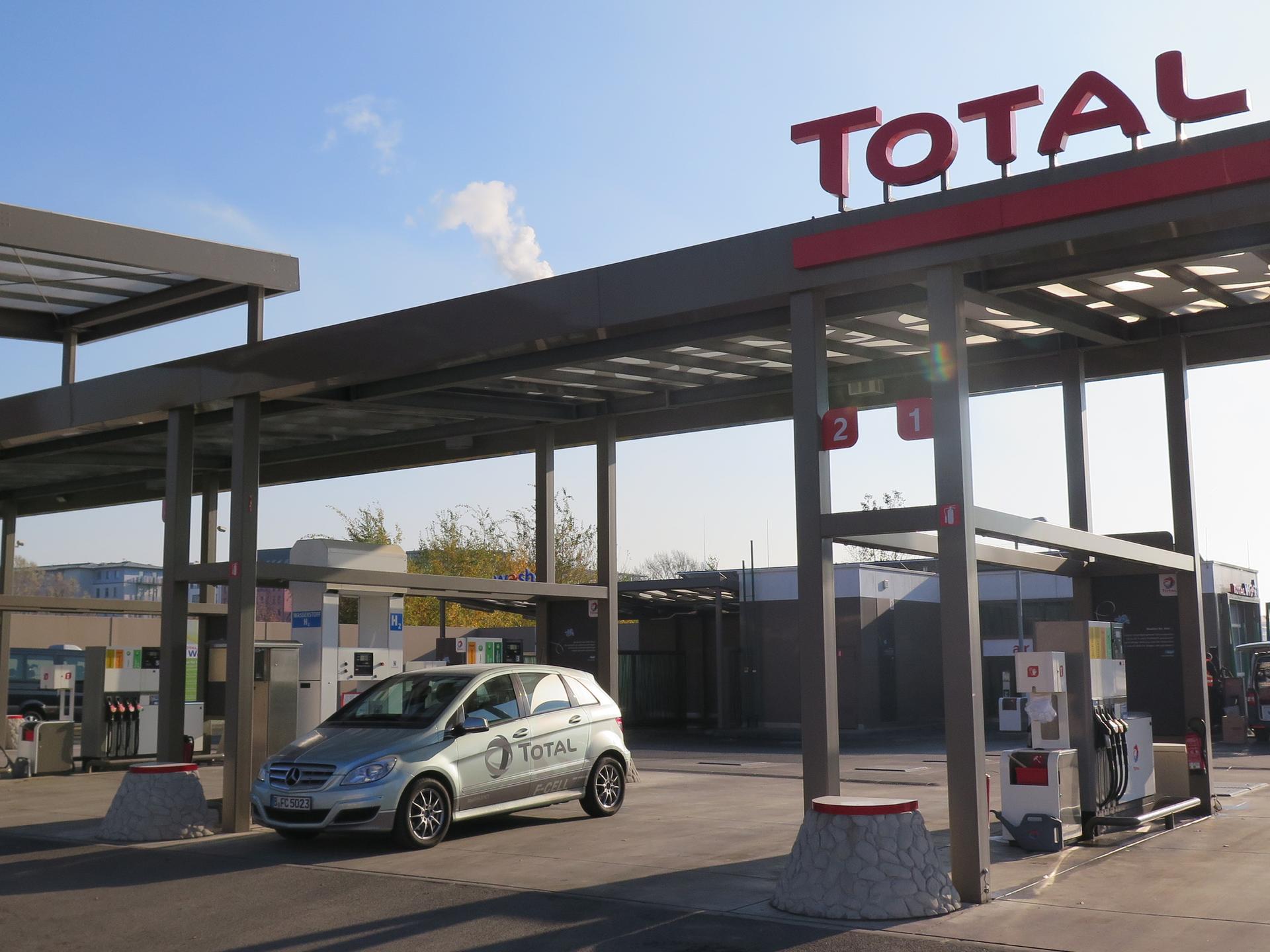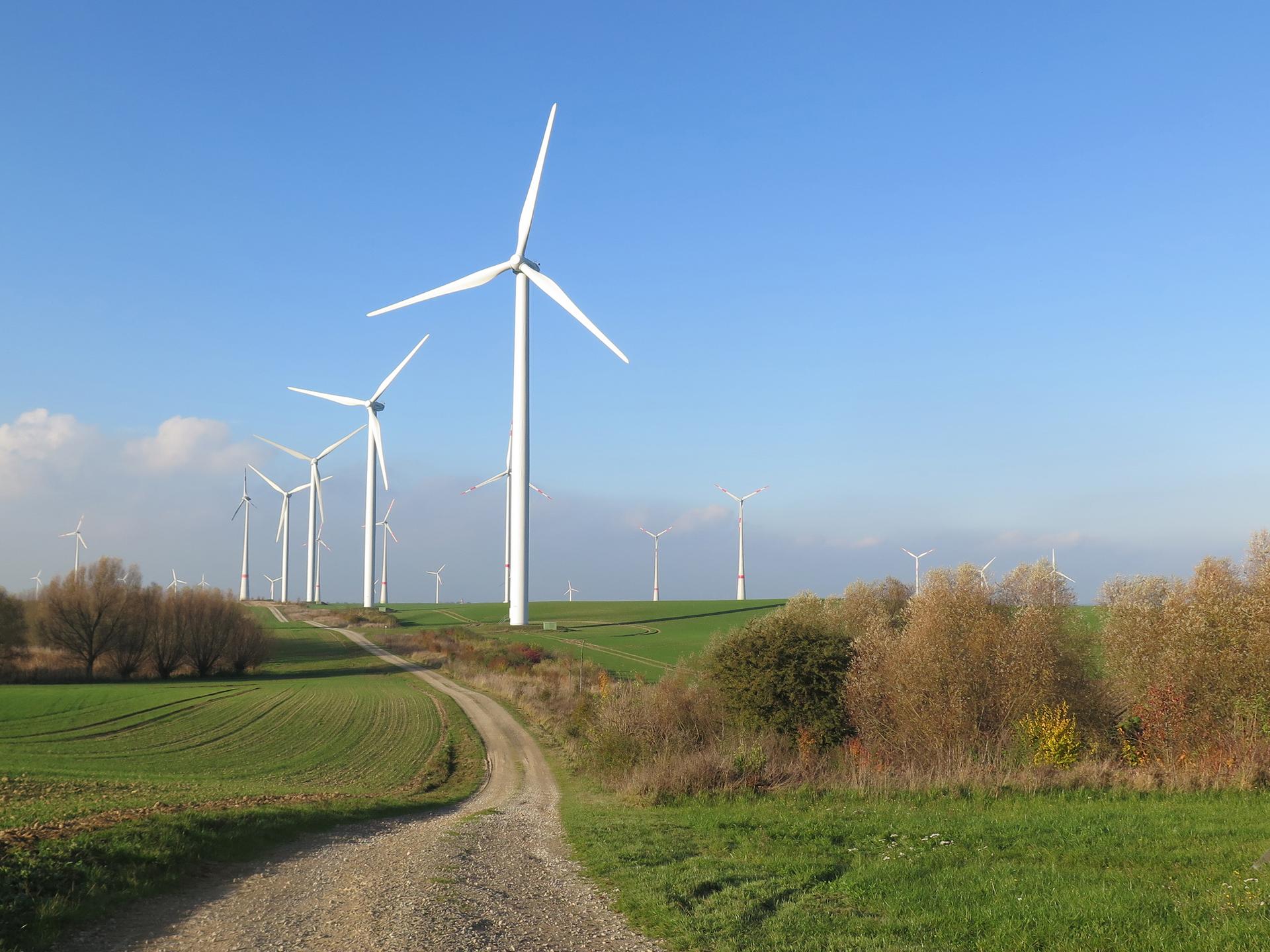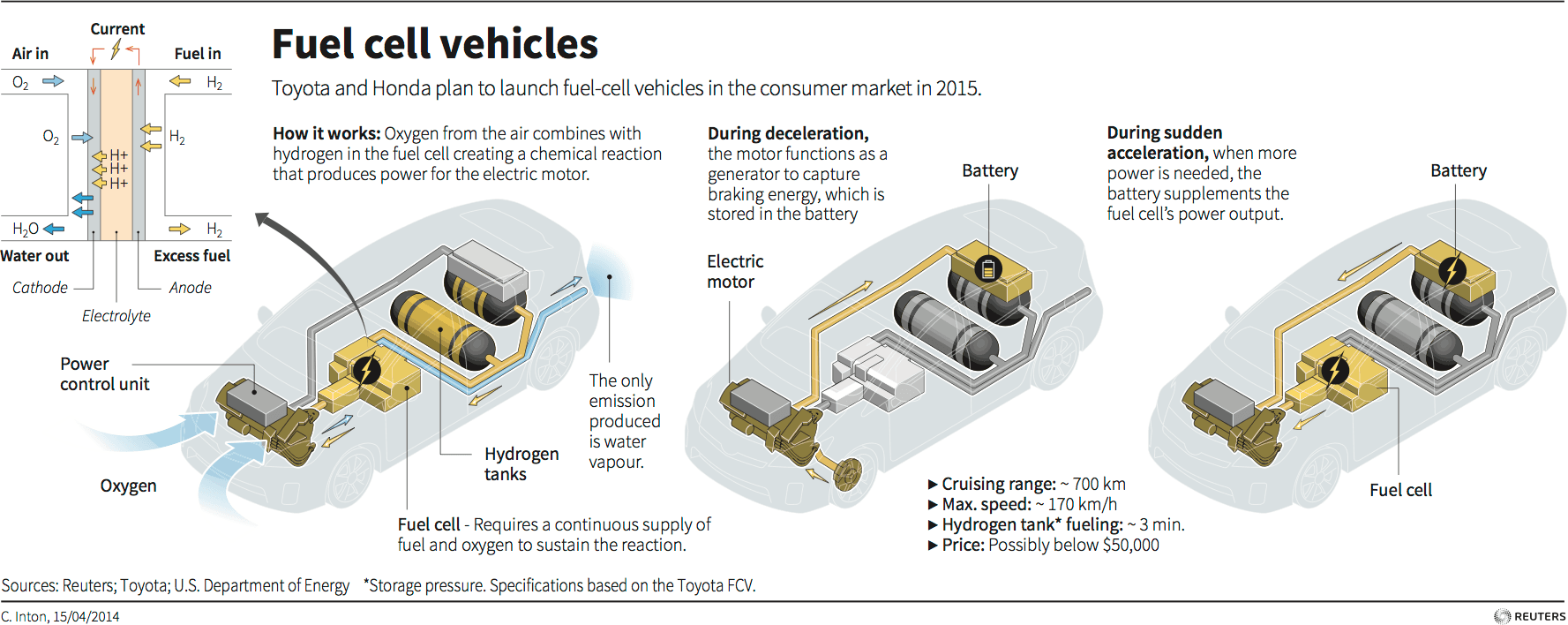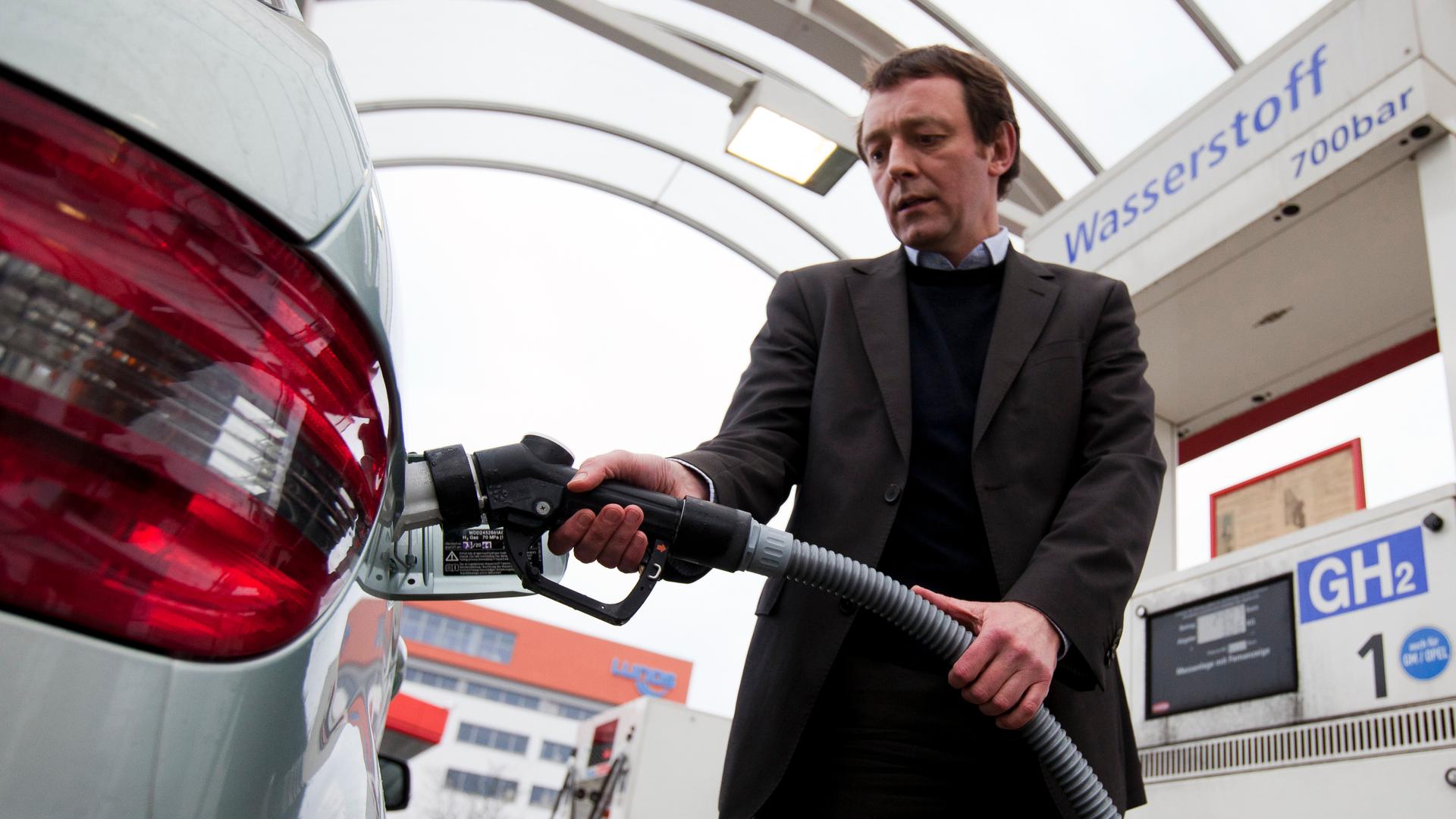The car of the future — the very near future — might be driven by the wind
Lutz Wiese of Vattenfall power company refuels a hydrogen-powered Mercedes at a filling station in Berlin. Vatenfall is a partner in the world's first direct wind-hydrogen power plant, in northern Germany. Using wind-generated electricity to create hydrogen fuel has long been a dream of green energy advocates.
In a city bursting with 20th century history and 21st century glitz, the scrap of Berlin I’ve found myself in on a grey winter’s morning is the definition of ordinary, an American-style mini-mart /gas station where my companions and I are ordering bad coffee to a soundtrack of generic schmaltzy pop.
But then I look out the window and it suddenly feels like the most exciting place in Berlin, because — yikes! I remember — we’re in the future! That car outside, the one we’re driving in, doesn’t run on gasoline or diesel fuel or batteries. It runs on hydrogen! The stuff that makes the sun go!

People have been fantasizing about hydrogen cars forever. It was the car of the future before the Prius and the Tesla were the car of the future. And it still is. But here I am, about to head off across the German countryside in a hydrogen-power Mercedes.
So we grab our coffees and head back out to fill up the car, a beautiful little silver hatchback, and it works pretty much the same as a regular car, which is the point, really — to help make the switch as seamless as possible, except that instead of gasoline that gets burned in an engine we’re tanking up with pressurized hydrogen gas that creates electricity in a fuel cell. And we get back in the car and head out and it’s quiet and smooth and exciting, but before long a comment from one of my traveling companions reminds me that I really should curb my enthusiasm. Because the future is still not quite here.
“Do you think we’ll make it to Prenzlau and back?”
The question comes from Lutz Weise of the giant energy company Vattenfall.
The reply from our driver, Manuel Fuchs, of the equally giant energy company Total: “I hope so.”
You see, it turns out that the pump back at the gas station didn’t actually work the way it was supposed to. We couldn’t top off the tank. And there isn’t another place to fill up on hydrogen between Berlin and where we’re going, a town called Prenzlau about 70 miles from here.
So it’s possible that before we get back, we’ll run out of gas. I mean hydrogen.
But we head off anyway, fingers crossed, and my companions and I are talking about the reason we’re here, Germany’s energiewende, perhaps the most radical energy transition ever undertaken. By the middle of this century, Germany plans to nearly eliminate fossil and nuclear power and get 80% of its electricity from renewable sources, including wind, solar, hydropower and biomass.
It’s a response to the dangers of climate change, nuclear accidents and reliance on foreign sources of energy. Already, just a few years in, the country gets more than a quarter of its electricity from renewables. And by many measures, the energiewende has been a remarkable success.
But I’m also getting a reality check on it.
“We’re still right at the very beginning of a new energy system in Germany,” Weise tells me. And there are huge challenges ahead.
More from the Series: Innovation to ease the green energy bottleneck
Part 1: How do you catch the sun to make electricity at night? This German inventor has an answer.
This car we’re riding in is one tiny part of that beginning. As we leave Berlin behind and get out into the countryside we start seeing bigger parts of it: windmills (wind turbines for sticklers) — big bunches of them looming over the horizon. They’re the most visible representation of the energiewende, but they also symbolize its limitations, because, in the industry parlance, wind and solar power are intermittent. They ebb and flow with the wind and the sun. Some days Germany actually gets more from them than it needs. But, Weise says, “there are other days where the production is close to zero.”
It’s a problem of supply and demand, Roland Kaeppner, with the hydrogen energy company McPhy, told me. “Supply of electrical energy (from wind and solar) doesn’t fit with demand of electric energy,” he says. “For example, a sunny Sunday, we (might) have a lot of energy generated by wind and sun, but you don’t have the demand.”

This intermittency of sun and wind power is a big problem, Kaeppner says. So “you need to find a way to store it” to use later, when there isn’t enough.
So that’s one of the big challenges here — how to fix that imbalance.
There are lots of strategies for meeting that challenge. I’ve written about some in the previous two parts of this series (part 1 / part 2). But one of the most intriguing is hydrogen. Which brings us back to the car I’m riding in, the place we’re going, and the guy I’m going to meet there: Robert Döring, head of communications at the green energy company Enertrag.
I meet Döring on a patch of bare dirt surrounded by broad, open fields. We made it to Prenzlau, a place in crowded Germany that feels like the middle of nowhere. But Döring’s company doesn’t need a lot of people. What it does need is wind. And there’s a lot of it here. And windmills, some looming right above us. And there’s a big concrete shed with a machine inside it that runs on some of that wind power and that Enertrag hopes will help fix the imbalance between renewable energy supply and demand.
“This project demonstrates that renewable energy is capable of providing energy, demand-sided,” Döring tells me. That is, when people need it, not just when nature provides it. “Even when wind turbines are not turning because the wind is not there, we store the wind power in the form of hydrogen, and we can use it for different purposes.”
In other words, it turns wind power into hydrogen. Hydrogen that can be stored, moved and turned back into electricity whenever it’s needed.
Döring opens the metal doors to the shed and ushers me into a big room with a bunch of pipes, cables and two big tanks, one with a bright blue “O” on it, the other with a bright red “H.” It’s an electrolyzer, a machine that uses electricity to split water into oxygen and hydrogen.
Like Döring said, you can use that hydrogen for lots of different things. But what makes it most important to the energy transition is that you can reverse the electrolysis process with something called a fuel cell to regenerate most of the electricity that went into it. You can use it to power anything that uses electricity — a home, a data center, or a car like the one that got us here from Berlin and — I hope — will get us back.
And here’s the key to the whole process, Döring says: “There is no emissions.”
In fact it only makes sense to do all this using carbon-free electricity.
“It’s all about decarbonizing the whole planet,” Roland Kaeppner had told me. He says it would be pointless to generate hydrogen for fuel cells with electricity from fossil fuels. But doing it from wind and solar — well, for many folks, that’s a giant step forward for the new green economy. Even a kind of holy grail for some.
And with its system here in Prenzlau, Enertrag is the first company to do it directly. When we step outside the electrolysis shed Robert Döring shows me where the juice is coming from — a cluster of 200-meter-high turbines a couple of kilometers away.
Döring admits that there are big challenges ahead for green hydrogen. The technology needs to be improved, costs need to come down. Policies need to be changed. And there’s a whole school of green tech folks who say that companies like Enertrag are actually betting on the wrong horse, that the future of green energy storage and mobility is in batteries. Elon Musk of Tesla is a very heavy hitter in that camp.
But Döring says batteries just don’t cut it for helping store power for a whole economy.
“We are talking about terawatt hours of electricity which has to be stored,” he says. “But in batteries you cannot store large scales of energy.”
And there’s a lot of momentum behind hydrogen right now. Here in Germany, some very big energy companies are involved, including Vattenfall and Total, which are partners with Enertrag in this project, and medium-sized ones like McPhy. Hydrogen fueling stations like the one we tried to fuel up at this morning are starting to pop up. Many city buses run on the stuff. And Mercedes is seeding the market with a few dozen of its fuel cell cars.
Back in the US, Hyundai, Toyota and Honda will all be selling or leasing fuel cell cars this year in parts of the country.
“What we see here is the beginning,” Döring says. “The future will show which option is best. We are one big step forward right now due to this hydrogen power plant. But we’ll see what the future brings.
Of course in the immediate future, there was the question of hydrogen just getting us back to Berlin.
On the road out of Prenzlau I glance at the fuel gauge and wonder aloud whether we’re going to make it back.
“Yeah, sure,” Manuel Fuchs says, but only if we crawl along the autobahn at 60 mph.
“I stay at 100 kilometers an hour,” he says, “because it takes lots of energy to drive really, really fast.”
And Germany wants to drive really, really fast — on the autobahn and in its energy transition.
An earlier version of this story had an incorrect spelling of Roland Kaeppner’s last name.

